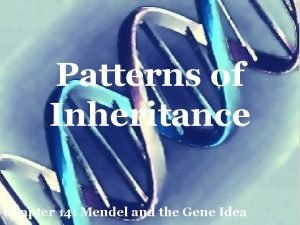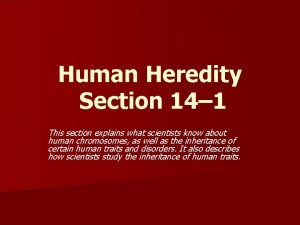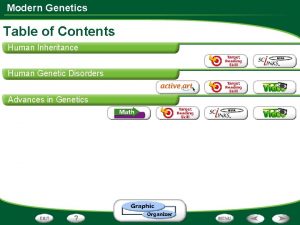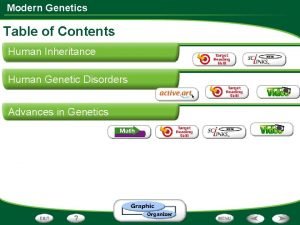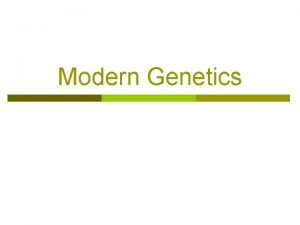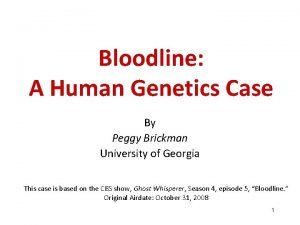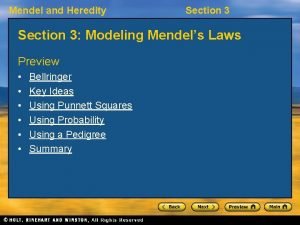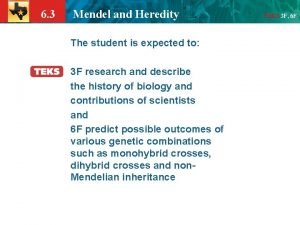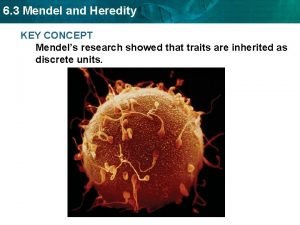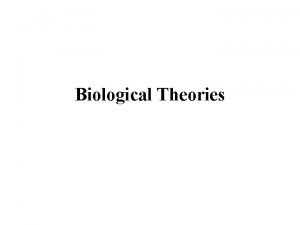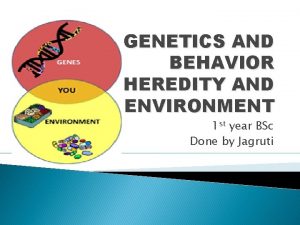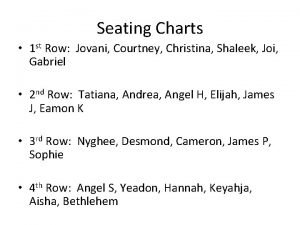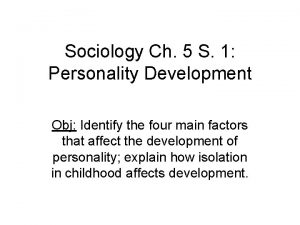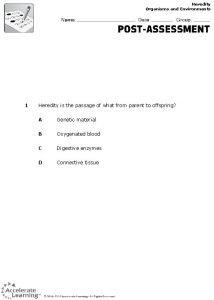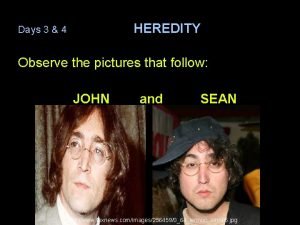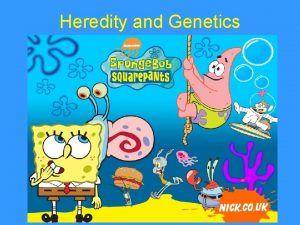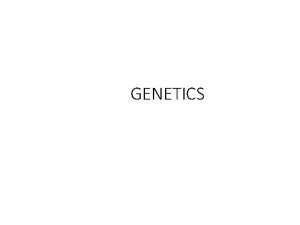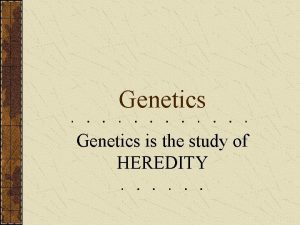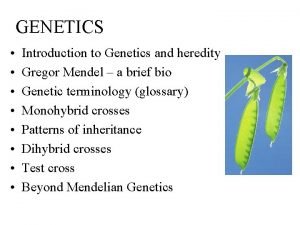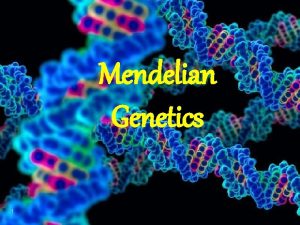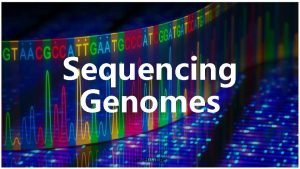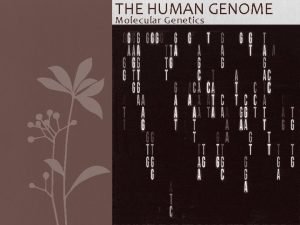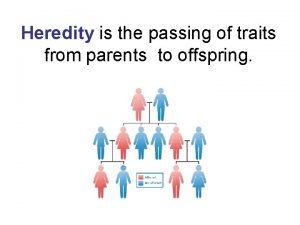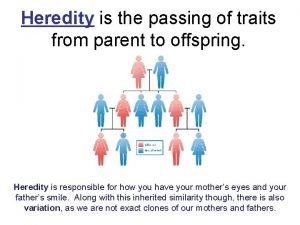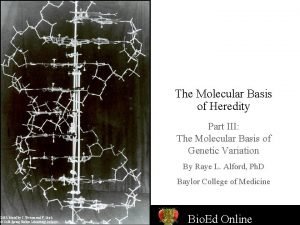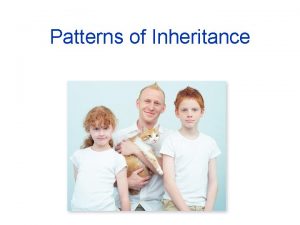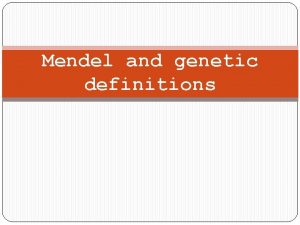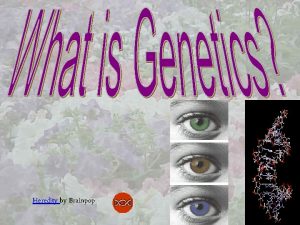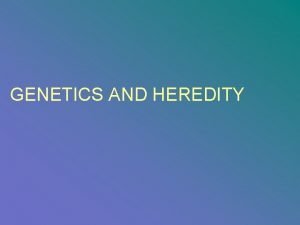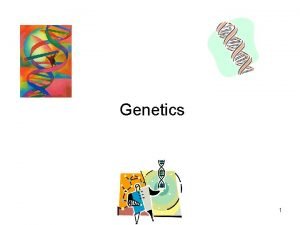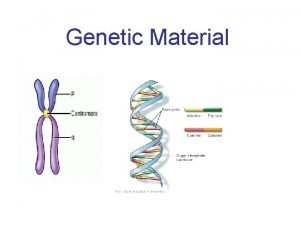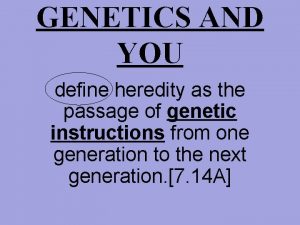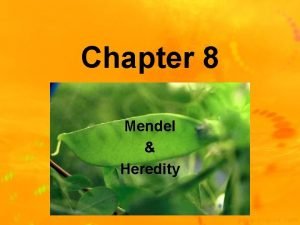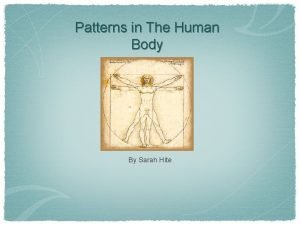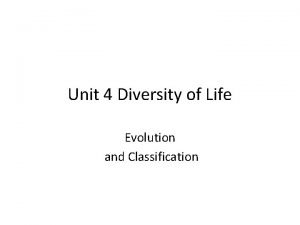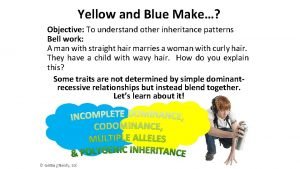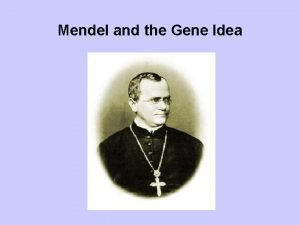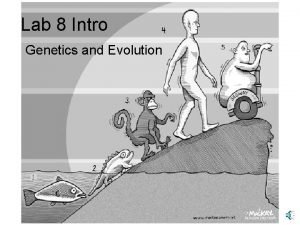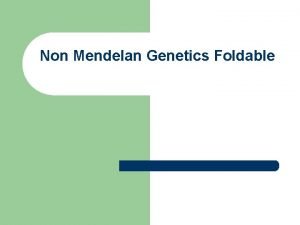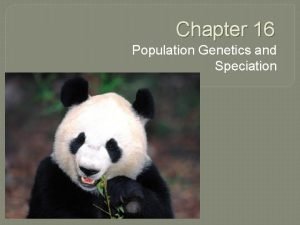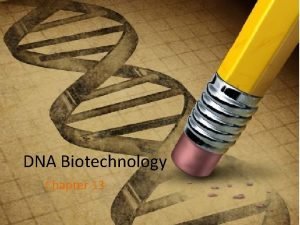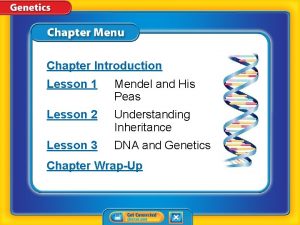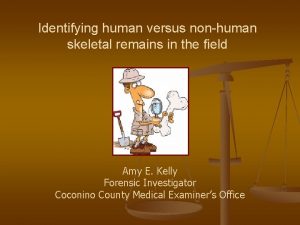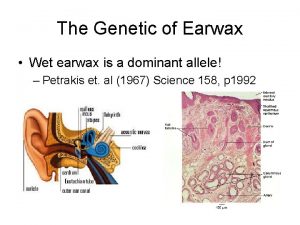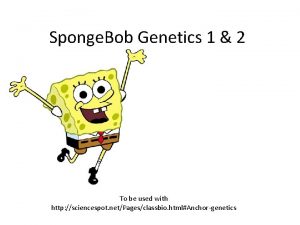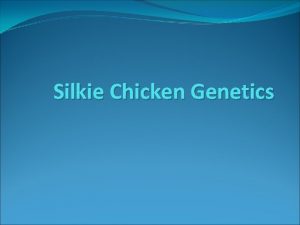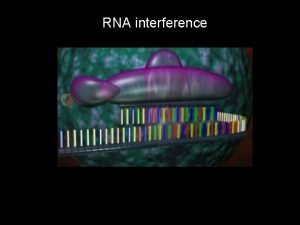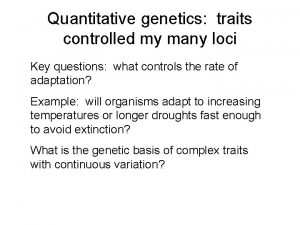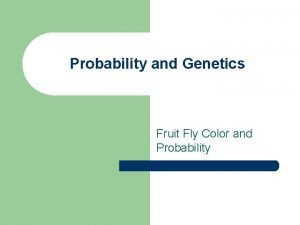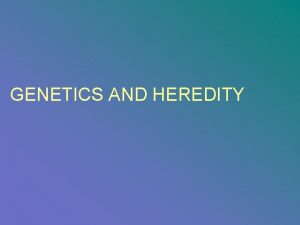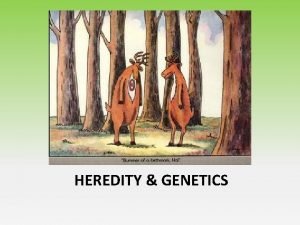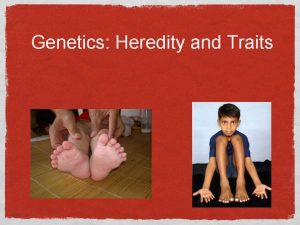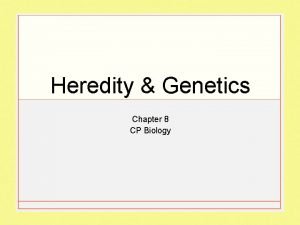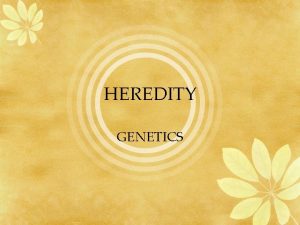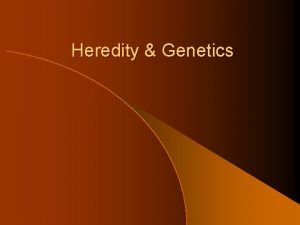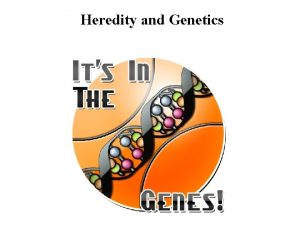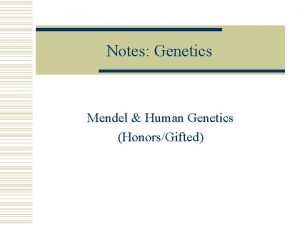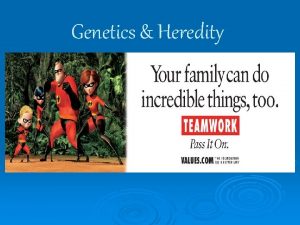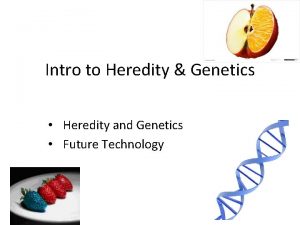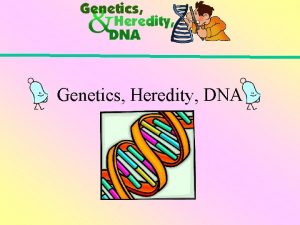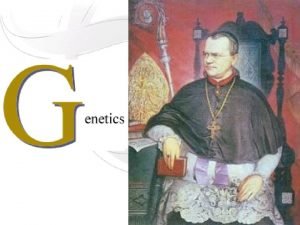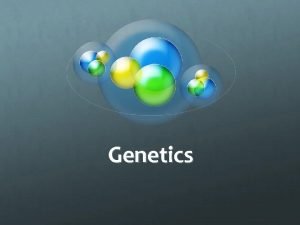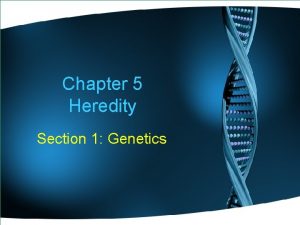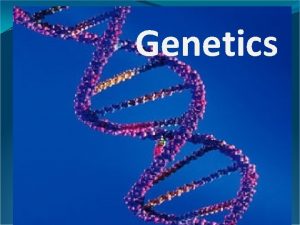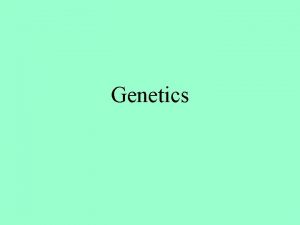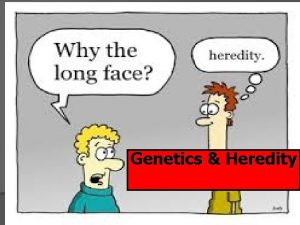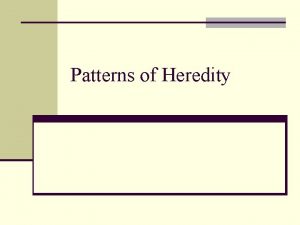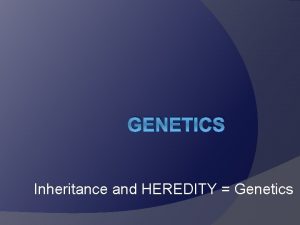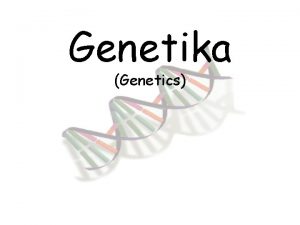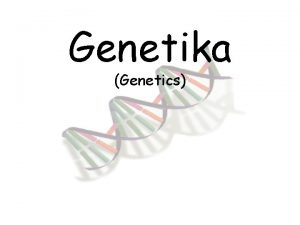Patterns of Heredity and Human Genetics A Look





















































































- Slides: 85

Patterns of Heredity and Human Genetics A Look at Genetic Complexities Chapter 12 Notes

What happens when heredity follows different rules? The Exceptions to Mendel’s Rules Section 12. 2

Section Objectives � At the end of this lesson, YOU will be able to: ◦ Distinguish between alleles for incomplete dominance and codominance. ◦ Explain the patterns of multiple allelic and polygenic inheritance. ◦ Analyze the pattern of sex-linked inheritance. ◦ Summarize how internal and external environments affect gene expression.

Remember Punnett Squares dd Heterozygous Chin Dimple (male) X d No Chin Dimple (female) Dd D d d

Remember Mendel? � His ◦ ◦ 4 conclusions were: The The Rule of Unit Factors Rule of Dominance Law of Segregation Law of Independent Assortment http: //www. pbs. org/wgbh/nova/orchid/images/amat_mendel. jpg

Exceptions to Mendel’s Rules � Sometimes, patterns of inheritance are not as simple as Mendel’s Rules imply. � The exceptions to Mendel’s Rules are when nature uses a different method of determining traits.

Gene Linkage � The Law of Independent Assortment can be broken when genes are found close together on the same chromosome. ◦ The genes will appear linked, or show up together. ◦ The closer the genes are to each other the more they will be inherited together.

Breaking the Rule of Dominance � Usually, a dominant gene produces a protein for the trait. � The recessive allele either produces a nonfunctional protein or no protein at all. ◦ So we see the dominant trait in hybrids because it is the only trait expressing a protein. DNA m. RNA Protein

Incomplete Dominance � When heterozygous individuals show an intermediate phenotype between the two homozygous phenotypes. ◦ Having one copy of a gene does not produce enough protein to completely mask the recessive allele. http: //www. miracosta. edu/home/rmooney/Mendelian%20 genetics_files/slide 0015_i mage 033. jpg

Incomplete Dominance � Snapdragons ◦ If you cross a red flower and a white flower, the resulting hybrid will be pink. �RR = red flower �rr = white flower �Rr = pink flower ◦ If you cross two pink flowers (Rr), you get: � 25% Red Flowers � 50% Pink Flowers � 25% White Flowers R R R r r r Rr Rr R r RR Rr Rr rr

Incomplete Dominance � Hair ◦ Straight (HH) ◦ Wavy (Hh) ◦ Curly (hh)

Codominance � When a heterozygous individual shows the phenotypic traits of both alleles. ◦ Both alleles produce a protein, which are seen in the hybrids. ◦ The traits do not blend!

Codominance � Feather Color in Chickens ◦ A black chicken would be BB. ◦ A white chicken would be WW. ◦ A hybrid, BW, would have a checkered appearance. �Both white and black pigments are seen in the offspring. B B W BW BW B B BB W BW WW

Codominance � Sickle Cell

Multiple Alleles � When a trait is controlled by more than two alleles. ◦ Each individual only owns two alleles, but others in the population may possess different types.

Multiple Alleles � Fur ◦ ◦ Color in Rabbits C = Dominant allele ch = Himalayan fur cch = Chinchilla fur ca = Albino fur C ch ca cch cbcb- Bugs Bunny

Multiple Alleles � Blood Types ◦ IA, IB, or i IAIA or IAi IBIB or IBi IA IB ii

Polygenic Traits � When one trait is controlled by more than one gene. ◦ The genes may be on the same or different chromosomes. ◦ Both genes have a single phenotypic effect.

Polygenic Traits � Coat Color in Labrador Retrievers ◦ Controlled by two different genes, the B gene and the E gene. ◦ A dihybrid cross of two black labs (Bb. Ee x Bb. Ee) results in: � 9 Black Pups � 3 Chocolate Pups � 3 Golden Pups � 1 Golden Pup with a brown nose and light eyes. http: //www. oakhillkennel. com/library/color. html

Polygenic Traits � Eye Color ◦ Brown Gene ◦ Green Gene

Multifactorial Traits � When traits are determined by several factors from the genetic makeup and the organism’s environment. ◦ The genes only represent the potential. ◦ Environmental influences turn on the genes at different times and in different amounts.

Multifactorial Traits � Temperature, nutrition, light, chemicals, and infections can influence gene expression. ◦ Arctic Foxes have coats that change color due to temperature.


Multifactorial Traits � Height, Intelligence, Cholesterol, Weight, Mental Illness, etc.

How do our chromosomes determine our sex? Sex Determination and Sex-linked Traits Section 12. 2

Sex Determination � Humans have a total of 46 chromosomes, or 23 pairs: ◦ 22 pairs of autosomes ◦ 1 pair of sex chromosomes � Autosomes ◦ All of the chromosomes that determine the traits other than sex. ◦ Come in different sizes with different genes on them. ◦ Pairs 1 -22

Sex Determination � Sex Chromosomes ◦ Determine the sex of the individual. ◦ Pair 23 �In females, these chromosomes match in the form of XX. �In males, these chromosomes are different, as in XY.

Sex Determination � The combination of sex chromosomes decides if you are a boy or a girl. ◦ A mother (XX) can only supply eggs that have an X chromosome. ◦ The father (XY) has some sperm with a X chromosome and some with a Y chromosome. X XX XX Y XY XY G- 50% XX; 50% XY P- 50% female; 50% male

Comparing the X and the Y

Sex-Linked Traits � Genes that are located on the sex chromosomes. ◦ The X chromosome contain many important genes that are necessary for survival. ◦ The Y chromosome contains the SRY gene which determines maleness.

Sex-Linked Traits � First observed in fruit flies (Drosophila). � Fruit flies have either red or white eyes. ◦ Thomas Hunt Morgan noticed that all of the white-eyed flies were male. ◦ Therefore, eye-color in flies is a sex-linked trait.

Sex-Linked Traits � Because the X chromosome is much larger than the Y, most sex-linked traits are on the X. � When writing the alleles for these traits, you must include the chromosomes that the individual has: Y Y Chromosome (no alleles) R X X Chromosome (red-eyed allele) Xr X Chromosome (white-eyed allele)

Sex-Linked Traits � Because males have only one X chromosome, they are more likely to get a single defective copy. X RY ◦ XRY- red-eyed male ◦ Xr. Y- white-eyed male r XY

Sex-Linked Traits � Because females receive two X chromosomes, they are more likely to get a dominant allele that can cover the effects of the recessive trait. � A carrier female has a recessive allele but does not show the trait (heterozygous) R R X X Homozygous Red-eyed Female R r X X Carrier Female X r White-eyed female (rare)

Sex-Linked Punnett Squares Homozygous Red-eyed Female x White-eyed Male X RX R Xr XR XR XR Xr X r. Y Y XR Y G- 50% XRXr 50% XRY P- 50% red-eyed female 50% red-eyed male

Sex-Linked Punnett Squares Heterozygous Red-eyed Female x Red-eyed Male XRXr XRY XR XR Y Xr XR Xr Xr Y G- 25% XRXR 25% XRXr 25% XRY 25% Xr. Y P- 50% red-eyed female 25% red-eyed male 25% white-eyed male

How do pedigrees show inherited traits within families? Understanding Pedigrees Section 12. 1

Pedigrees �A graphic representation of traits inherited within a family. ◦ Allows scientists to trace the history of a genetic disorder. ◦ Uses symbols to represent individuals. �Circles represent females �Squares represent males �If the symbol is shaded, the individual is affected by the trait. Normal Female Normal Male Affected Female Affected Male

Pedigrees � Inherited traits can be followed from generation to generation. ◦ Horizontal lines connect two individuals who have mated. II ◦ Vertical lines represent the offspring of a union. Bb I Bb 1 2 bb 2 BB 3 Bb 4 5

Rules of Pedigrees � Sex-Linked Autosomal vs. ◦ If more males are affected by a trait than females, it is probably sex-linked. ◦ If it affects males and females equally, it is probably autosomal.

Rules of Pedigrees � Dominant Recessive vs. ◦ If a trait skips a generation, it is recessive. ◦ If the trait is found in each generation, it is probably dominant.

Rules of Pedigrees � Identifying Genotypes ◦ If any males are carriers, the trait is autosomal. ◦ If a male has a sexlinked trait, his mother was probably a carrier.

Autosomal Recessive � Affects males and females equally. � Skips generations (appears in some generations but not in others). � Males can be carriers

Autosomal Dominant � Affects males and females equally � Does not skip any generations.

Sex-Linked Recessive � Affects males more than females. � Skips generations. ◦ Must use the chromosomes (XY or XX)

Example #1: Albinism Are males affected more frequently that females? NO Autosomal Disorder A- normal a - albino Does the disorder skip generations? YES Recessive Disorder (P 1) Autosomal Recessive

Example #2: Hemophilia Are males affected more frequently that females? YES Sex-Linked Disorder Does the disorder skip generations? YES + = normal Recessive Disorder H = hemophilia Sex-Linked Recessive

Pedigree Practice Genetic Trait: ACHOO (Sneezes in response to light) A #1 - Is this trait sexlinked or autosomal? B #2 - Is this trait dominant or recessive? #3 - What is the genotype of individual A? C #4 - What is the genotype of individual B? #5 - What is the genotype of individual C? #6 - What is the genotype of individual D? D

Karyotype �A picture of an individuals chromosomes. ◦ Homologous chromosomes are paired up. ◦ Pairs are arranged by size. ◦ Karyotypes can help diagnose chromosomal disorders.

Karyotypes � When arranging the chromosomes: ◦ Autosomal Chromosomes are placed in order by size. ◦ The Sex Chromosomes are pair 23.

Karyotypes � What to look for: ◦ The Sex Chromosomes: �Male (XY) or Female (XX) �Is there an odd number (XXY, XYY, XO, XXX) ◦ The Autosomes �Are there two or three chromosomes for pair 21? �Trisomy 21 Down Syndrome

Example #1 Number of Autosomes: 44 Number of Sex-Chromosomes: 1 Karyotype: 45 (X) Phenotype: Female. Turner Syndrome

Example #2 Number of Autosomes: 44 Number of Sex-Chromosomes: 3 Karyotype: 47 (XYY) Phenotype: Male Jacob’s Syndrome

Example #3 Number of Autosomes: 44 Number of Sex-Chromosomes: 3 Karyotype: 47 (XXY) Phenotype: Male Klinefelter Syndrome

What is the genetic basis for determining blood types? Understanding Blood Types

Blood Types in Humans � Your body produces antibodies that attack any foreign objects within you. ◦ Usually, this fights bacteria, viruses, or fungi. � All of your cells have antigens on their surface. ◦ Antigens are cellular nametags. ◦ Your body makes antibodies to fight off anything without your particular antigen.

Blood Types in Humans � Your special antigens are made by your DNA. � The antigens found on the red blood cells determine your blood type. ◦ ◦ Type A B AB O

Type A Blood Genotype IAIA or IAi Antigens A antigens Antibodies Anti-B antibodies

Type B Blood Genotype IBIB or IBi Antigens B antigens Antibodies Anti-A antibodies

Type AB Blood Genotype I AI B Antigens A antigens and B antigens Antibodies No Antibodies

Type O Blood Genotype ii Antigens No antigens Antibodies Anti-A and Anti-B antibodies

Rh Factor � Another antigen on the surface of the RBC, is the Rhesus Factor. ◦ Named after it was discovered in Rhesus Monkeys � People who have the Rh factor are positive. � People without the Rh factor are negative.

Blood Donations Anti. Rh rh a Anti. A B rh person’s blood type combines their ABO type and Rh factor. Type A+ rh � Commonly, rh Anti. A Anti. B Anti. Rh rh Anti. A rh rh Type ABrh ◦ Type A neg. ◦ Type O pos.

Blood Donations �A person cannot receive any blood that contains an antigen that they posses the antibody for. ◦ Type A individuals produce anti-B antibodies. ◦ Giving that person type B blood can have dangerous effects. ◦ The anti-B antibodies will cause the Type B blood to stick together. �This is called clumping.

Blood Donations � The Universal Recipient ◦ Produces no antibodies ◦ Can receive all types of blood ◦ Type AB+ � The Universal Donor ◦ RBC’s have no antigens. ◦ Can give blood to anyone ◦ Type O-

Determining Blood Types A A I I Type A x B B I I Type B IB IB A I A B I I G: 100% IAIB IA A B I I P: 100% AB

Determining Blood Types Type AB x IA IB Type O ii i i A I i G: 50% IAi IB B I i P: 50% Type A 50% IBi 50% Type B

Determining Blood Types Hospital Mix-Up On a busy night at the Plainsboro Hospital, three families delivered three healthy baby boys. Unfortunately, the babies became mixed up during a rush and no one knows which baby belongs to which family. The nurses were able to take blood samples from each parent and each baby. Use your knowledge of blood type genetics to figure out which baby belongs to each family. Parent Blood Type Baby Blood Type Mr. Robinson AB Baby #1 O Mrs. Robinson B Baby #2 AB Mr. Jones O Baby #3 A Ms. Jones AB Mr. Jackson B Ms. Jackson B Baby #1 belongs to the Jacksons Baby #2 belongs to the Robinsons Baby #3 belongs to the Jones

Characteristics of Blood System � Codominance ◦ Both A and B are dominant. ◦ In a hybrid (AB) both types of antigen will be present. � Multiple Alleles ◦ The ABO blood group has three alleles that produce four phenotypes. � Polygenic ◦ Two genes control blood type: ABO and Rh factor

How do scientists follow genetic disorders in our genome? When Genetics Goes Wrong

Cystic Fibrosis � Inheritance ◦ Autosomal Recessive ◦ Chromosome #7 � Symptoms ◦ Abnormally thick mucous clogs pores in lungs, liver, pancreas.

Cystic Fibrosis Gene Therapy is a hopeful avenue of treatment for those with cystic fibrosis. Here’s how it works: 1. Insert a working copy of the gene into a virus. 2. Load the virus into an inhaler. 3. Have the patient breath in the virus with the working copy. 4. The virus then injects its DNA and the working CF gene into the patient’s cells What would be one potential downside to using gene therapy?

Phenylketoneuria (PKU) � Inheritance ◦ Autosomal Recessive ◦ Chromosome # 12 � Symptoms ◦ Victims are unable to metabolize phenylalanine properly. ◦ Leads to mental retardation.

Phenylketoneuria (PKU) All babies are tested for PKU in the first few days. How would being diagnosed with PKU affect your life?

Sickle Cell � Inheritance ◦ Autosomal Codominant ◦ Chromosome # 11 � Symptoms ◦ Defective hemoglobin becomes sickleshaped ◦ Pain crises result when, cells clog blood vessels. http: //www. ehponline. org/docs/2004/112 -6/bloodcells. jpg

Sickle Cell AA Normal RBC/ Susceptible to Malaria AS Normal RBC and Sickle Cells/ Resistant to Malaria SS Sickle Cells/ Resistant to Malaria If sickle-cell is so bad, why has the gene not been taken out of the genome?

Huntington’s Disease � Inheritance ◦ Autosomal Dominant ◦ Chromosome # 4 � Symptoms ◦ Progressive neurological disorder. ◦ Nerve cells begin to deteriorate resulting in a loss of coordination. ◦ Begins in late 40’s or early 50’s.

Huntington’s Disease is autosomal dominant. If one of your parents have it, you have a 50% chance of inheriting this progressive disorder. Question #1 Genetic testing can determine if you have inherited the dominant allele or not. If one of your parent’s had it, would you want to know if you have the disease or not? Question #2 Should the results of genetic testing be given to employers by insurance companies? Is having the trait cause for firing somebody, even if they have not shown any symptoms? h h Hh Hh H hh hh h

Color Blindness � Inheritance ◦ Sex-linked Recessive ◦ X Chromosome � Symptoms ◦ Unable to distinguish between red and green colors.

Color Blindness How would colorblindness affect the way you see the world? Tritanopia Deuteranopia Protanopia Normal Vision

Hemophilia � Inheritance ◦ Sex-linked Recessive ◦ X Chromosome � Symptoms ◦ Unable to clot properly because of missing Factor VII. ◦ Seen in the Royal family of Britain

Hemophilia

Down Syndrome � Inheritance ◦ Chromosomal Nondisjunction ◦ Trisomy 21 � Symptoms ◦ Mild mental retardation ◦ Simian Crease, Epicanthal fold, shorter limbs, poor muscle tone, protruding tongue

Down Syndrome Women over the age of 35 increase the chances of a DS child up to 1 in 378 (over 45 is 1 in 30). An amniocentesis extracts some fetal cells to prepare a karyotype. If you found out that your child would be born with Trisomy 21 (Down Syndrome), would you support terminating the pregnancy?

Other Traits in Humans � Polygenic Traits ◦ Eye Color- 2 genes ◦ Skin Color- 3 genes � Multifactorial ◦ Height ◦ Cholesterol ◦ Behavioral Traits
 Look up and to the left
Look up and to the left Genetics is the study of heredity and variation
Genetics is the study of heredity and variation Chapter 17 the beginning of the life cycle
Chapter 17 the beginning of the life cycle Dice and coin
Dice and coin Chapter 11 complex inheritance and human heredity test
Chapter 11 complex inheritance and human heredity test 14-1 human heredity
14-1 human heredity Chapter 11 human heredity section 11-3
Chapter 11 human heredity section 11-3 Chapter 14 human heredity
Chapter 14 human heredity Human genetics concepts and applications 10th edition
Human genetics concepts and applications 10th edition Eclat algorithm
Eclat algorithm Human inheritance modern genetics answer key
Human inheritance modern genetics answer key Modern genetics human inheritance answer key
Modern genetics human inheritance answer key Modern genetics human inheritance answer key
Modern genetics human inheritance answer key Biologists search the volumes of the human genome using
Biologists search the volumes of the human genome using Bloodline a human genetics case answer key
Bloodline a human genetics case answer key Section 3 mendel and heredity
Section 3 mendel and heredity Parts of chromosomes
Parts of chromosomes Role of heredity
Role of heredity Section 3 mendel and heredity
Section 3 mendel and heredity Mendel 9 3 3 1
Mendel 9 3 3 1 Section 3 mendel and heredity
Section 3 mendel and heredity Section 3 mendel and heredity
Section 3 mendel and heredity Heredity and crime
Heredity and crime Heredity
Heredity Flocabulary genes and heredity answer key
Flocabulary genes and heredity answer key Dating serves several important functions that include
Dating serves several important functions that include Picture analysis activity 1
Picture analysis activity 1 Activity 1 picture analysis
Activity 1 picture analysis Look at the picture in activity 1
Look at the picture in activity 1 Brainpop heredity worksheet answer key
Brainpop heredity worksheet answer key An unchanging, biologically inherited behavior pattern.
An unchanging, biologically inherited behavior pattern. Mendelian genetics concept map
Mendelian genetics concept map Heredity is best described as the -
Heredity is best described as the - Pictures of heredity
Pictures of heredity Heredity examples
Heredity examples Genetics
Genetics ____________ is the study of heredity.
____________ is the study of heredity. Mendel
Mendel Heredity terminology
Heredity terminology What are the basic units of heredity
What are the basic units of heredity Heredity torrent
Heredity torrent Heredity
Heredity Flower structure
Flower structure Organisms that reproduce asexually
Organisms that reproduce asexually Cpalms heredity
Cpalms heredity Molecular basis of heredity
Molecular basis of heredity Early ideas about heredity
Early ideas about heredity Heredity
Heredity Heredity
Heredity A gene carries the for a trait brainpop
A gene carries the for a trait brainpop The scientific study of heredity *
The scientific study of heredity * What is a pheontype
What is a pheontype Heredity acrostic
Heredity acrostic Heredity
Heredity Heredity is the passage of
Heredity is the passage of Heredity
Heredity Patterns in human body
Patterns in human body Chapter 11 section 1 basic patterns of human inheritance
Chapter 11 section 1 basic patterns of human inheritance Chapter 11 section 1 basic patterns of human inheritance
Chapter 11 section 1 basic patterns of human inheritance Can different species reproduce
Can different species reproduce Alimentary canal
Alimentary canal 8.3 human needs
8.3 human needs Chapter 8 human needs and human development
Chapter 8 human needs and human development Human and non human nouns
Human and non human nouns Andalusian chicken incomplete dominance
Andalusian chicken incomplete dominance Section 1 meiosis
Section 1 meiosis Pedigree miscarriage symbol
Pedigree miscarriage symbol Multiplication and addition rule genetics
Multiplication and addition rule genetics Genetics
Genetics Chapter 22 genetics and genetically linked diseases
Chapter 22 genetics and genetically linked diseases Sexual reproduction and genetics section 1 meiosis
Sexual reproduction and genetics section 1 meiosis Genetics foldable
Genetics foldable Population genetics and speciation worksheet answer key
Population genetics and speciation worksheet answer key Chapter 10 sexual reproduction and genetics
Chapter 10 sexual reproduction and genetics Pap protein synthesis worksheet
Pap protein synthesis worksheet Genetics and biotechnology chapter 13
Genetics and biotechnology chapter 13 Chapter 5 genetics lesson 1 mendel and his peas
Chapter 5 genetics lesson 1 mendel and his peas Human vs non human bones
Human vs non human bones Gni definition ap human geography
Gni definition ap human geography Earwax type genetics
Earwax type genetics Susie roundpants
Susie roundpants Blue black splash genetics
Blue black splash genetics Forward genetics
Forward genetics Genetics model
Genetics model Genetics
Genetics Probability in genetics
Probability in genetics



